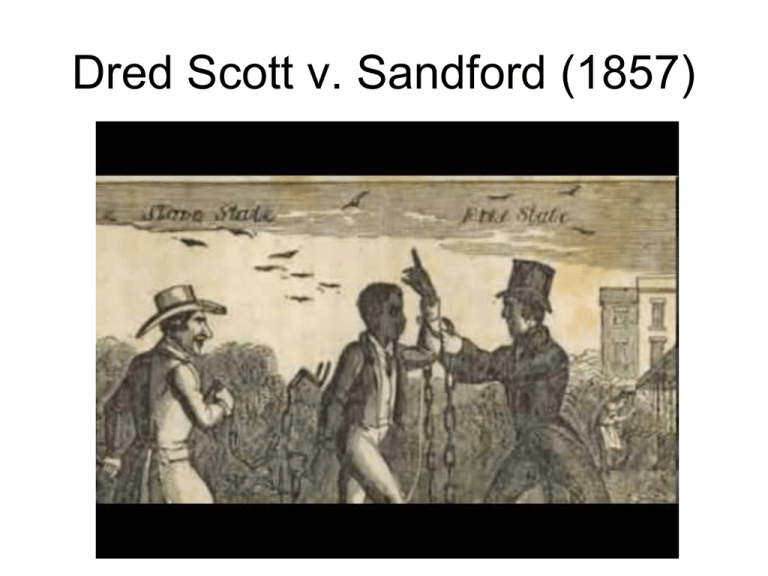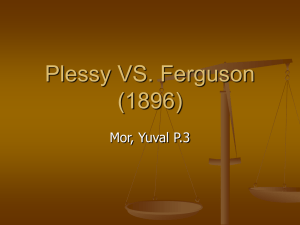US regents thematic essays – Supreme Court Decision
advertisement

Dred Scott v. Sandford (1857) Background: The Missouri Compromise • 1803: U.S. purchases Louisiana Territory from France • 1820: Compromise allows slavery in Missouri, forbids slavery in territory north of latitude 36°30′, and admits Maine as free state • 1821: Missouri admitted as slave state Dred Scott v. Sandford: Facts • 1833: Dred Scott sold to Dr. John Emerson in Missouri • 1833-36: Emerson and Scott reside in Illinois, a free state • 1836-37: Emerson and Scott reside in a free portion of the Louisiana Territory (Wisconsin) • 1843: Scott’s owner dies Scott sued his master’s widow for his freedom since he had lived in a free state for a lengthy period of time. Court case went to the Supreme Court for a decision - Can a slave sue for his freedom? - Is a slave property? - Is slavery legal? The United States Supreme Court (Chief Justice Roger B. Taney) ruled that all people of African ancestry—slaves as well as those who were free—could never become citizens of the United States and therefore could not sue in federal court. The court also ruled that the federal government did not have the power to prohibit slavery in its territories because it deprived citizens of their constitutional protection of their property. • The Supreme Court also ruled that Congress could not stop slavery in the newly emerging territories and declared the Missouri Compromise of 1820 to be unconstitutional. Lasting Effects • Southerners thought it would crush the antislavery movement because slavery was now the supreme law of the land • Republican Party effectively used the court decision as a propaganda tool • The Republican party gained support and momentum • Lincoln elected president in next election – 1860 • South Carolina seceded from the Union, and the Civil War promptly began A major factor that Led to the Civil War Plessy v Ferguson (1896) • After the end of the Civil War, the Black codes of the 1860s, and later Jim Crow laws, were intended to deny African Americans of their newly won political and social rights granted during Reconstruction. • Plessy was one of several Supreme Court cases brought by African Americans to protect their rights against discrimination. Background • Activists in Louisiana were looking for a person to help them challenge the Separate Car Act in Louisiana. • The act made blacks ride in separate train cars from whites. • They found a man who was 1/8 black named, Homer Plessy, who could pass as a white man. • On June 7, 1892 Homer Plessy would make a trip on the East Louisiana Railroad. • After buying his ticket and taking his seat he would tell the conductor of his race and refusal to switch cars. • The penalty for sitting in the wrong car was either 20 days in jail or a $25 fine. • He was then arrested and spent one night in jail and released in the morning on bond. Homer Plessy Court Case • Plessy argued that the acts violated his 13th and 14th amendment rights. • The judge was John Howard Ferguson, who had recently declared that train cars traveling in more than one state could not operate under the Separate Car Act. • 13th Amendment- Neither slavery nor involuntary servitude, except as a punishment for crime whereof the party shall have been duly convicted, shall exist within the United States, or any place subject to their jurisdiction. • 14th Amendment- No State shall make or enforce any law which shall abridge the privileges or immunities of citizens of the United States; nor shall any State deprive any person of life, liberty, or property, without due process of law; nor deny to any person within its jurisdiction the equal protection of the laws. • Plessy appealed, claiming that he had been denied equal protection under the law. The Supreme Court handed down its decision on May 18, 1896. • Justice Henry Brown wrote: That the Separate Car Act does not conflict with the Thirteenth Amendment, which abolished slavery. A statute which implies merely a legal distinction between the white and colored races -- a distinction which is founded in the color of the two races, and which must always exist so long as white men are distinguished from the other race by color -- has no tendency to destroy the legal equality of the two races...The object of the Fourteenth Amendment was undoubtedly to enforce the absolute equality of the two races before the law, but in the nature of things it could not have been intended to abolish distinctions based upon color, or to enforce social equality, as distinguished from political equality, or a commingling of the two races upon terms unsatisfactory to either. • The majority opinion of the Supreme Court claimed that the Fourteenth Amendment aimed to establish the equality of the races, but was not intended to abolish distinctions based on color or to enforce social equality. Furthermore, they stated the Louisiana law was ureasonable because states could legally segregate the races in the exercise of their police powers. • As a result, city and state governments across the South, and in some other states, maintained their segregation laws for more than half of the 20th century. Jim Crow South • It was not until 1954 in Brown v. Board of Education that the Supreme Court overturned Plessy.







